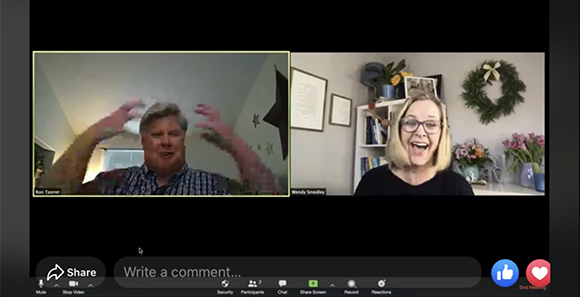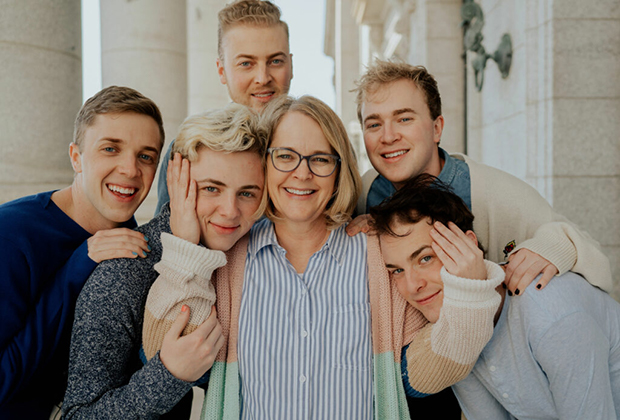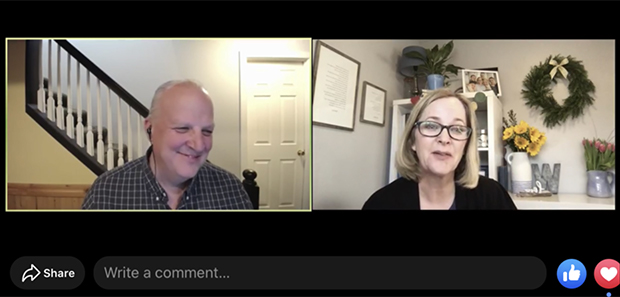How Live Social Media Events during COVID-19 Are Changing FamilySearch’s Future
Contributed By Sydney Walker, Church News reporter

Wendy Smedley, right, interviews Ron Tanner of FamilySearch during a Facebook live event on April 8, 2020. Screenshot of the FamilySearch Facebook page.
Article Highlights
- FamilySearch is spreading the joy of family history through livestream interviews during the pandemic.
“They’re sharing stories with us, they’re sharing stories with each other, and when it ends, we’re feeling a little more connected.” —Wendy Smedley, FamilySearch
Related Links
One of the reasons Wendy Smedley loves storytelling is because she grew up in a home where stories weren’t often shared.
“Both of my parents grew up in disadvantaged childhoods,” she said. “It was so painful, they never talked about it. My dad had two or three stories that he would tell us on repeat.”
Her father was an only child. Both of her mother’s parents died before her mother graduated from high school. She grew up without grandparents and without an extended family. “I grew up without stories.”
“It was something I really wanted for my kids,” she said. “As a young mom, it became really important to me to document our stories and provide what I didn’t have. I’ve always loved that, and I’ve loved telling the story of today as a way to just build and strengthen connections.”
Smedley works as a marketing manager for FamilySearch. For the past several weeks, she has been hosting live interviews with family history enthusiasts on FamilySearch social media channels as a way to help people connect during this time of COVID-19 isolation.
“We want to go to where people are and be with them,” Smedley said. “We want to (virtually) go into people’s homes.”
FamilySearch’s livestreams are held every Tuesday and Thursday at 11:00 a.m. MDT on Instagram and Wednesday at 4:00 p.m. on Facebook. Live youth events are held Wednesday at 7:00 p.m. MDT on Facebook, and Spanish streams are held Thursday at 4:00 p.m. on rotating weeks. Viewers from nearly 50 countries have participated so far.
“It’s really exceeded our expectations,” said Stephen Valentine, senior vice president of FamilySearch International. “I think this is a turning point for us to become a much more global, virtual organization through these online tools. … We’ll never go back. This has changed us forever, in the very positive.”
Benefits of the Live Social Media Events
When the COVID-19 outbreak hit in March, Valentine and others made the difficult decision to close the Family History Library in Salt Lake City, Utah. Family history centers around the world also closed. They wondered how they could continue to offer help and services while sharing uplifting messages during a troubling time.
That’s when Smedley suggested the idea of livestream interviews on social media. The interviews would focus on building a community and encouraging “connection”—rather than a focus on research, records, or marketing new tools.

Wendy Smedley, middle, is pictured with her children. Smedley works as a marketing manager for FamilySearch and has been hosting live events on Facebook and Instagram during the COVID-19 outbreak. Photo by Jorden Bree.
“It’s really an opportunity for us to globally connect with people in a way that resonates with the sort of intimacy of being from one home to somebody else’s home,” Smedley said. “It’s much more about the community than it is about us.”
The livestreams aren’t traditional family history classes or webinars, Smedley said. The interviews are meant to be informal and conversational. The most important part of the livestreams is the interaction with viewers.
“They’re sharing stories with us, they’re sharing stories with each other, and when it ends, we’re feeling a little more connected and a little more edified,” she said.

Wendy Smedley, top, interviews Maria Eckersley during a FamilySearch live Instagram event on March 24, 2020. Screenshot of the FamilySearch Instagram page.
Christine Higgins, a small business owner who lives in Fairbanks, Alaska, has felt the impact of COVID-19. She is a frequent viewer of FamilySearch’s livestreams. Focusing on family history “makes everything not seem quite so dire,” she said.
“These livestreams are just such a fun pop of color. They put family history into my regular workday, my regular weekday,” she said. “I sit in my comfy chair and I just get this little dose of family history communication, and I love it.”
Higgins’s favorite part of the livestreams is the interview style. “The friendly nature of the interviews makes me genuinely feel like these people are already my friends,” she said. “And that is the magic of family history and making those connections.”
With the informal and conversational style, those being interviewed often feel more comfortable sharing personal and often vulnerable experiences. Valentine said, “We want to let people tell their full story and tell the full story of their ancestors—I mean, the good and the bad, the triumphs, the tragedies.
“I think that’s the model for us in FamilySearch,” he continued. “It’s the authentic, true stories that can help people through good times and bad, overcome challenges and gather, strengthen, and have resiliency.”
Another motive behind the livestreams is to broaden the definition of family history, Smedley said. “Really, it’s like practicing love. It’s reaching out to those in your life and building connections. We talk about family history when it makes sense but in ways that sort of broaden the appeal.”
Amy Perkins, a BYU–Idaho graduate interning with Smedley, has been tracking comments and responding to questions on the livestream social media posts. One thing she has noticed is interest from viewers from a variety of stages in life.
“We try to make sure that we’re getting guests that talk to those different kinds of audiences, people who are more involved in family history and others who want a little something family history–related that they can do,” Perkins said.
Impact on Future FamilySearch Efforts
FamilySearch live social media events are scheduled to continue through May. Meanwhile, Valentine said FamilySearch is looking at ways to expand the reach of online communication.
“One of the things that we’re really seriously looking into is, how do we make the Family History Library into really a virtual library?” he said.
Though there are approximately 5,000 family history centers around the world, the social media livestreams are an example of how “we can bring the library to you,” he said. This is particularly advantageous in areas where Church members have to travel far distances to go to a family history center.
“How can we have these events going on in (areas such as) Mexico, Brazil, Europe, and Asia? We’re a global organization, so we certainly don’t want this to end in North America. We want to try to expand that reach around the world,” he said.

Wendy Smedley, right, interviews Ty Davies of FamilySearch during a Facebook live event on April 1, 2020. Screenshot of the FamilySearch Facebook page.
To find the schedule of the FamilySearch livestreams or learn how to participate, visit FamilySearch.org/blog/en/familysearch-live-community. Those who don’t have social media accounts can view the Facebook livestreams on FamilySearch’s YouTube channel.
Go to FamilySearch.org/together for more family history resources during COVID-19.
